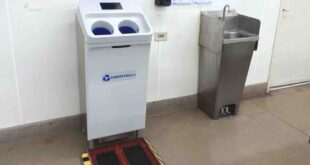The durability, lightness, and strength of composite materials make them applicable in many industries from building, construction, and infrastructure (BCI) to wind energy, transportation, and telecoms. To encourage adoption, though, composites manufacturing must meet the global demand for sustainable materials. Jussi Roto explains the vital role that fibre selection plays in sustainable composites production
One of the key sustainability metrics that manufacturers can be judged on is the carbon footprint of their products. This can be very complex to calculate for overall processes, given the contributions from different components, supply chains, shipping, and energy consumption at each stage.
This is as true for composites as any other material. If we control the resin production and profile manufacturing phases, we can examine the environmental impact specifically associated with making reinforcement fibres.
It’s also useful to compare composite manufacturing methods with the materials that they could replace. Techniques like pultrusion and pull-winding are less energy-intensive than producing metallic alternatives: aluminium, a common competitor, has an embodied energy of 190-230 mJ energy needed to extract and produce 1 kg, whereas fibreglass requires only 13-54 mJ kg-1.
This holds true despite the 1,400-1,500°C temperatures required to melt the glass, a significant energy consumption. Glass fibre has been produced industrially for almost 100 years, and producers and researchers have refined production techniques over this time. Energy consumption has been reduced through heat recovery, improved insulation and combustion optimisation, contributing to a more efficient process.
The perspective of a lifetime
The manufacturing phase often receives the most attention when we consider the environmental effects of original equipment manufacturing (OEM). However, if we really want our products to be sustainable, isn’t it important to consider their entire lifetimes? Wind turbines, made mostly from glass fibre reinforced polymer (GFRP) and carbon fibre (CF), operate for 20-25 years. The corrosion resistance and limited maintenance requirements of composite materials means energy and cost demands are front-loaded. Still, manufacturers’ studies show that the net energy payback time is less than 12 months for a complete installation of a wind turbine.
The transport phase is also an important consideration. While manufacturing locally to customers can reduce shipping distances, we cannot avoid emissions from transporting materials from manufacturer to end user. This ability to optimise the delivery chain to supply global customers with nearby production is part of the thinking behind Exel’s factories around the world.
A natural alternative
Natural fibres are relatively new to industrial composites manufacturing. A natural fibre is one sourced from a naturally growing material: hemp, flax and wood can all be used. The nova-Institute has reported the carbon footprint of natural fibres as between 0.3-0.5 kg CO2e per kg fiber. The mechanical properties of natural fibre-based composites are currently different than the others discussed, but still, they are impressively strong, stiff and lightweight relative to their density.
Flax is available in a continuous roving form, which is preferred for pultrusion. The individual filaments are long enough to withstand the pulling strain involved in profile manufacturing. Usage and development in industry, like Volvo’s collaboration with sustainable lightweighting company and flax fibre provider Bcomp, suggests this natural fibre can be a legitimate future option for composites solutions providers.
Greater interest and investment from big industries, like automotive and wind energy, will help to bring down the price of natural fibres as the manufacturing processes are developed further.
Clearly, the path towards sustainability and carbon neutrality is not straightforward for the composites industry. While the rise of natural fibres is welcome and represents an area of notable progress, carbon and glass fibres still offer greater performance and have more established, optimised manufacturing processes. Central to sustainability assessments is the lifetime calculation: how will the final product affect emissions over the decades of its use?
Jussi Roto is sourcing manager for materials and technology at composites manufacturer Exel Composites.
 Engineer News Network The ultimate online news and information resource for today’s engineer
Engineer News Network The ultimate online news and information resource for today’s engineer



